
Chevrolet Corvettes are one of the few cars that symbolize The American Dream. From the sports car’s launch in 1953 to the latest 2020 Stingray, Corvettes have been known for their high-performing engines and sleek bodywork.
Now more than ever, they are accessible as much as they are eye-catching. Chevrolet’s impressive vehicles are ideal for both classic restoration projects and modern sports car driving. Depending on the generation and condition of the car, you may have the perfect DIY project on your hands or a fresh ride ready to rev its engine.
Deciding which classic Corvette to buy is challenging, so it’s crucial to put in the right amount of research. Top Flight Automotive will give you a more in-depth look into the buying process and the different factors that can affect your decision.
Looking for a specific topic in the guide? Skip to:
How to Buy a Classic Corvette — Common Tips
You’re ready to buy a Corvette, but you’re stuck at a crossroad — what classic should you buy?
There are a few aspects to consider before you dive into the process. It’s always best to have a plan and budget, as well as a bit of know-how.
Restoration Project vs. Drivable Sports Car
Buying a classic Corvette gives you the freedom to enjoy an earlier model like the C3 Stingray, or a more advanced sports car like the C7.
With so many options available, what are you looking to get out of the sports car? There are three primary uses for classic cars:
- Restoration project
- Immediate drivability
- Show car
If you’re a DIY enthusiast looking to restore a Corvette, later models will most likely be your best bet. Are you looking to restore the Corvette to its heyday? Or, do you want more of a quick fixer-upper? You have three options when it comes to restoration:
- Restoring the Corvette to its original condition
- Working with modern “restomod” features
- Installing a complete replacement
Depending on your budget, time and effort, restoration can be fun and rewarding. It’s an engaging hobby that brings the satisfaction of completing a challenging task. But always make sure you know what you’re getting into when buying a used car. Older generations may demand custom parts, along with both interior and exterior fixups. Restoring a more modern Corvette can be a bit easier but with fewer unique customizations.
If you’re looking for a sports car to get you to work and go on adventures, you may want to look into newer Corvettes. More advanced models have improved gas mileage and don’t demand custom parts. If anything, they may need a few tune-ups, but nothing significant enough to cross over the line into restoration.
Finally, the occasional Sunday drive and car show may be more your speed. If you want to enter your Corvette into shows, you can go either way — restoration or ready-to-drive options.
How to Bargain for the Best Price — New or Used
Phase two of the buying process comes down to new vs. used cars. A new Corvette will undoubtedly have a higher upfront cost compared to a used one. However, they are much more affordable compared to other luxury sports cars on the market. For example, the new 2020 C8 is just under $60,000, while the Porsche 911 Carrera starts at $97,400.
There is also a surplus of later-generation Corvettes like the C7 throughout the industry, making them more affordable through dealership discounts.
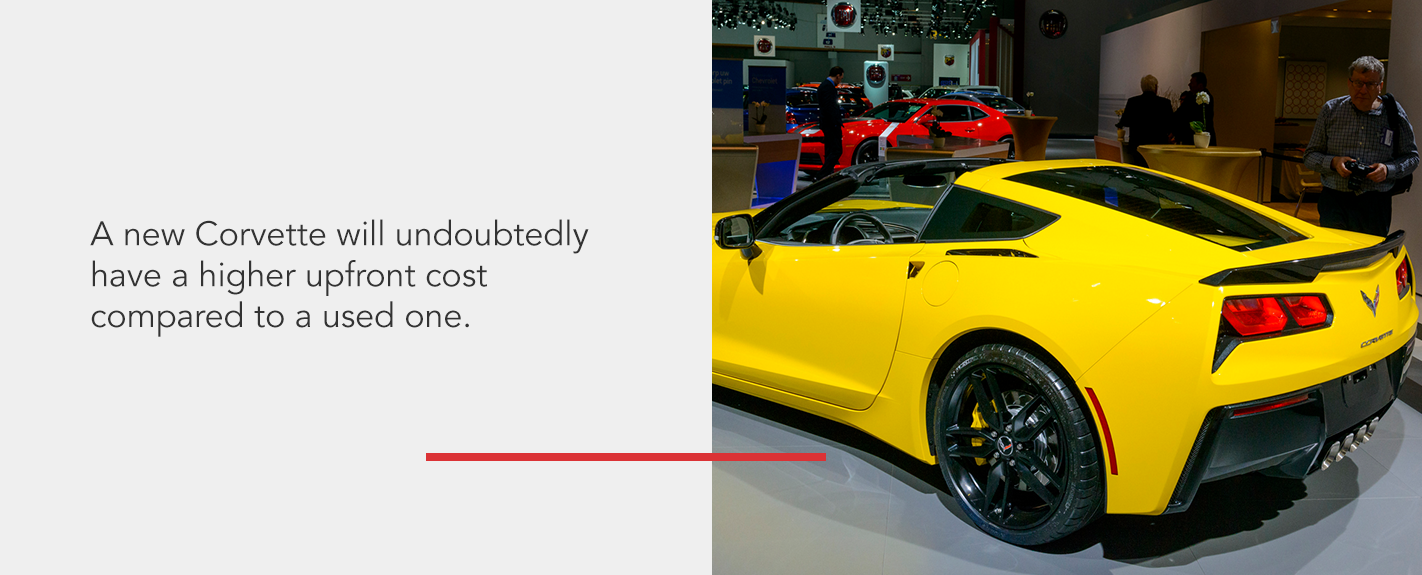
Here are a few tips on how to get the best price for your new Chevrolet:
- Know the market value of the car
- Look around at different dealers
- Consider other existing incentives
Unless you’re purchasing one of the more recent Corvettes like the C7 or new C8, most other generations will be used. The term “used,” however, does not always indicate poor condition. Many Corvette owners keep their vehicles in mint condition for personal use and to sell them later on.
Used car prices are lower compared to new vehicles, but it’s important to know what you’re getting into. Do your research and find a good investment that matches your expectations. When it comes to lowering the price of a used car, check out these tips:
- Note any damage to support your negotiations
- Get a mechanic to inspect the car
- Learn about its records
When you know what to look for, it can help you work out the best price of both new and used cars.
What to Look for in a Used Corvette
If you choose to invest in a used car, there are many aspects you will want to consider before making a deal. Sometimes, it takes more effort that goes beyond a few questions — get underneath the car and make the proper inspections.
-
- Inspect the car’s frame, body and birdcage.
- Check the original composite body panels for cracks or damage.
- Look at the front clip to see if it’s the original version or an aftermarket piece.
- Examine the frame for rust, especially around the rear axle, as well as the birdcage.
- Check for leaks, brake wear, component damage and vibrations.
- Inspect the tires.
After you’ve assessed the vehicle, you may want to request the expertise of a mechanic. If they find severe damages or problems, you may need to walk away from the sale.
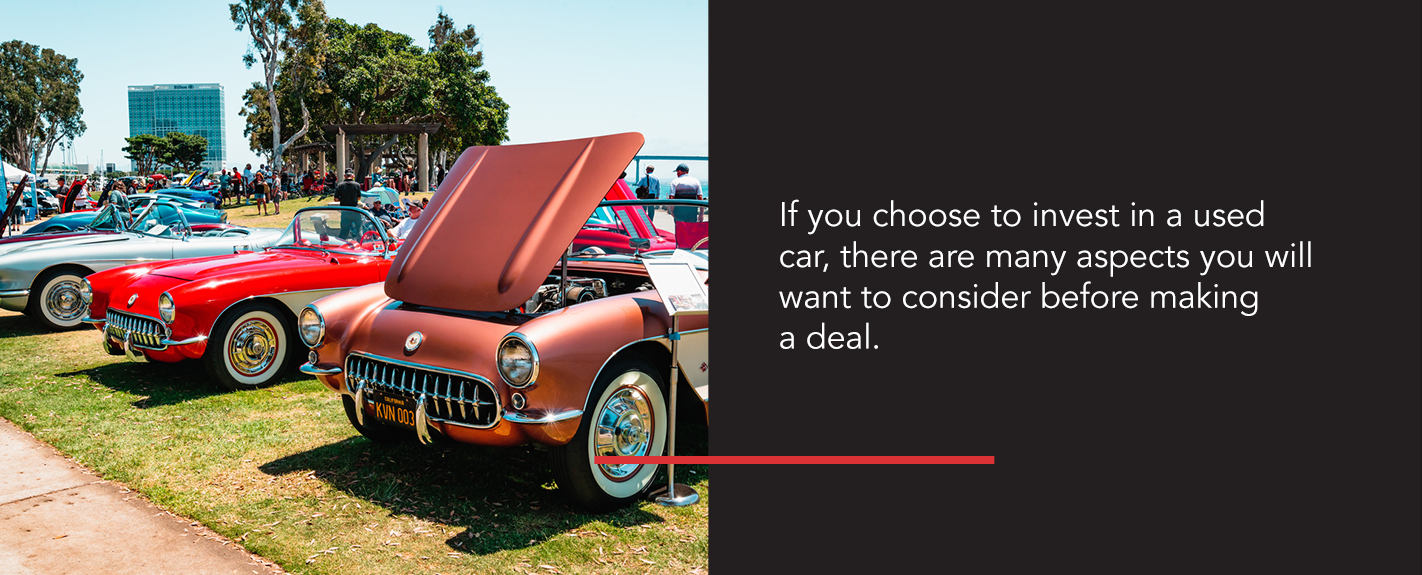
You will also want to ask the seller or dealer for the Corvette’s previous maintenance and repair records. The more documents provided, the better idea you’ll have of its current and past conditions. The extent of the Corvette’s history will show if the previous owner knows what they’re talking about and gives you more details about the car.
Make sure you take the Corvette for a test drive, keeping an ear out for odd sounds and smells while focusing on how the vehicle feels.
Understanding what goes into buying a classic car can help you drive away with a valuable Corvette at a reasonable price that’s in good or excellent condition.
Classic Corvette Buying Guide
The best classic Corvette to buy comes down to what intrigues you the most. Maybe you’re nostalgic for classic interior design. Perhaps you want the latest in performance and speed. Are you more interested in modern technology or a car’s history? You might want a model with a unique body style and unusual exterior features or one that provides excellent comfort and efficiency.
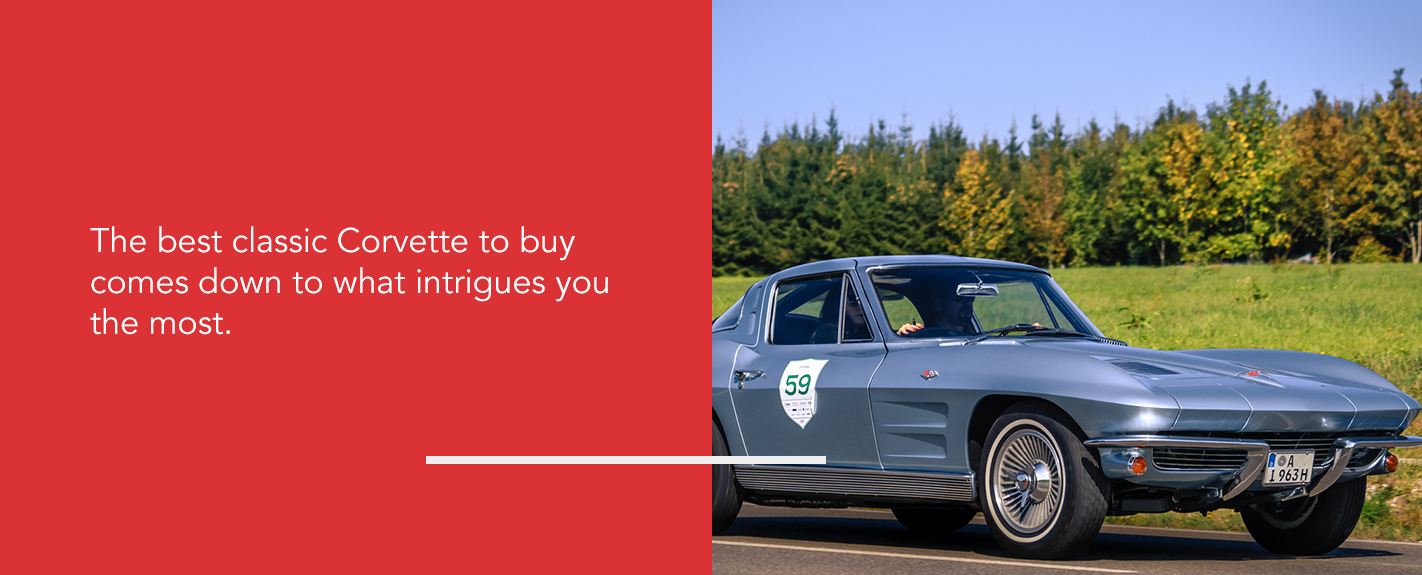
Your goal may be to restore one of the earlier Corvettes to its original condition. Or, you may be more passionate about the performance of the mid-generation sports cars.
Additional factors that can affect the buying process include:
- Customization: Today, you have many, many more customization options compared to the 1950s, ’60s and ’70s. While some of the first generation Corvettes offered several personalization options when it came to performance and color schemes, you now can upgrade everything from your seats, tires and interior upholstery to the cockpit technology and engine horsepower.
- Maintenance and restoration: Both the upkeep and restoration of older generation Corvettes may require more time and effort to acquire the correct custom parts and accessories. With newer Corvettes, preservation and modifications are more accessible.
- Parts available: The further you go back in time, the trickier it may be to find the exact solutions you want. While it’s simple to find components for a C7, the right parts for a C3 or C1 will be scarcer and likely more expensive.
- Price estimates: The rarer the sports car, the higher the price tag — especially if it’s in excellent condition. For example, the Corvette’s C1 and racing models are more sought after because they are uncommon. How much work has been done or if the sports car has original parts and interior components also affect the price.
While the earlier Corvette generations are a bit more challenging to find, restore, maintain and customize, it may be the exact project you’re looking to take on. You may also be interested in the high-performing engines of the later Corvette generations, which gives you customization and availability.
Classic Corvette Price Guide
If you’re planning to buy an antique Corvette, it’s essential to know the car’s value so that you know you’re getting a good deal. Classic car value is determined by several factors, including rarity, condition and market demand. Generally speaking, you’ll pay the most for a classic car that is rare, high in demand and in excellent condition.
When classic cars are appraised, they are categorized into one of the following classifications.
- Excellent: The vehicle has been perfectly restored to its original condition.
- Very good: The car is fully restored and in good working condition.
- Good: The car needs some restoration work to increase its value.
- Fine: The vehicle is in good condition and has many functional original equipment manufacturer (OEM) parts.
- Restorable: The car is in poor condition but can be restored.
- Parts car: The vehicle is undrivable with no functional value.
As you research classic car values, you’ll typically find that the higher the classification, the higher the car’s cost. However, retail values can also vary based on factors like model type, engine configuration and mileage.
When it comes to vintage Corvette pricing, the early generations tend to be the most expensive. Below you’ll find an overview of the going rates for various classic Corvette models.
C1 Corvette Price Guide
First-generation (C1) Corvettes are some of the rarest and most coveted collector cars on the market. The 1953 model is particularly scarce, as only a few hundred of these hand-made models still exist today. If you’re fortunate enough to find a C1 Corvette in excellent condition, you’ll need to pay top dollar for it.
According to the National Automobile Dealers Association (NADA), the current, average retail values for C1 Corvettes are as follows:
- 1953: $193,300
- 1954: $80,600
- 1955: $102,300
- 1956: $65,900
- 1957: $61,500
- 1958: $49,300
- 1959: $48,400
- 1960: $56,300
- 1961: $54,400
- 1962: $54,400
C2 Corvette Price Guide
Second-generation (C2) Corvettes saw the birth of the Sting Ray model in 1963. The Sting Ray achieved instant popularity for its sleek coupe body style and powerful performance. Because C2 Corvettes were only produced from 1963 to 1967, they are some of the most sought-after vintage Corvette models.
The 1963 Corvette is the most expensive Corvette on the market. The 1963 model marks the first Corvette coupe, and Chevrolet produced only 10,000 of them with the split-window design.
NADA reports C2 Corvette average retail values as:
- 1963: $267,700
- 1964: $40,000
- 1965: $47,000
- 1966: $54,000
- 1967: $56,100
C3 Corvette Price Guide
The third-generation (C3) Corvette debuted in 1968 with a more aggressive, shark-like body style. Produced from 1968 to 1982, the C3 Corvette went through numerous evolutions. ZR-1 racing packages became available for the first time in 1969, and Corvettes featured a new fastback body style for the first time with the release of the 1981 model. Overall, third-generation Corvettes marked the start of a transition toward a design with more modern features.
According to NADA, average retail values for popular C3 Corvette models include:
- 1968: $133,000 (two-door coupe)
- 1970: $49,500
- 1976: $17,000
- 1981: $20,000
C4 Corvette Price Guide
Chevrolet gave fourth-generation (C4) Corvettes a complete redesign after concluding the previous C3 series. C4 Corvettes featured sharp-nosed front ends, tapered back ends, side vents and angular roofs, creating a futuristic look. These 1984-1996 models also had powerful engine configurations and improved aerodynamics for the optimal driving experience.
The C4 series also showcased several special releases, including a 40th-anniversary model in 1993 and a Collector’s Edition in 1996.
Average C4 retail values, according to NADA, include:
- 1984: $7,300
- 1988: $7,550
- 1993 (40th anniversary convertible model): $17, 200
- 1996 (two-door convertible, Collector’s Edition): $22,700
- 1996 (two-door convertible, Grand Sport): $34,500
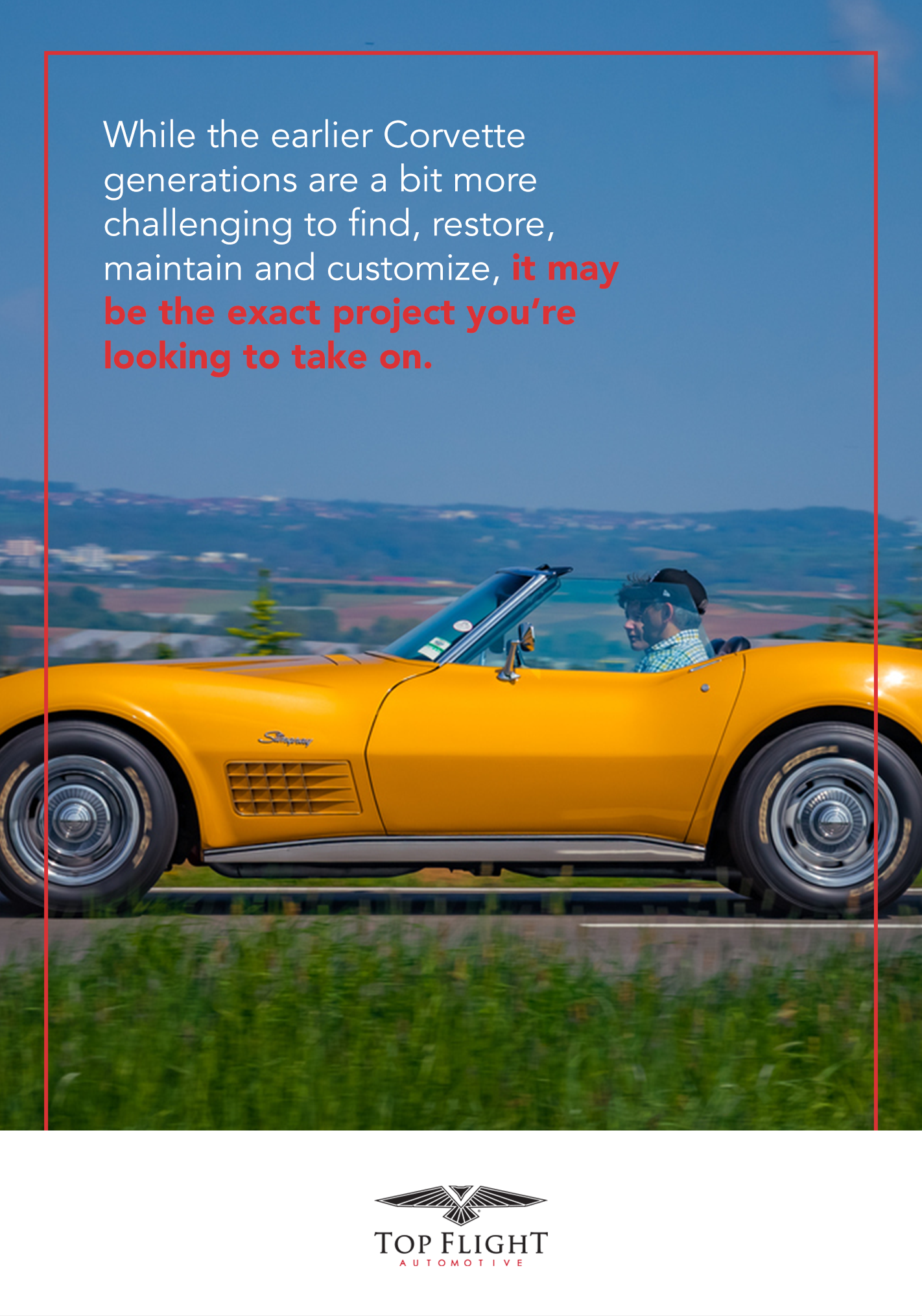
Which Corvette Generation Sparks Your Interest?
Each generation has defining features that separates it from the others. Earlier years may spark the interest of a DIYer while more recent models may catch the eye of enthusiasts ready to hit the pavement.
First Generation 1953-1962 — C1
When the C1 Corvette hit the car industry in 1953, it opened the door to seven more generations of innovation and radical changes. Revered as the “dream car,” the C1 is one of the rarest Corvette models. The first 300 C1s were built by hand in Michigan — yes, by hand, making them that much more exclusive.
In 1955, the V8 engine was introduced, along with a three-speed manual transmission. Chevrolet restyled the Corvette in 1956 to show off various new features, such as rolled-up windows and exposed headlamps. It was also the first time removable hardtops were introduced.
In 1957, the C1 gained a four-speed manual transmission, and dual headlights made an appearance in 1958. If you can find a first-generation Chevrolet Corvette, you’ll get to experience a game-changing icon.
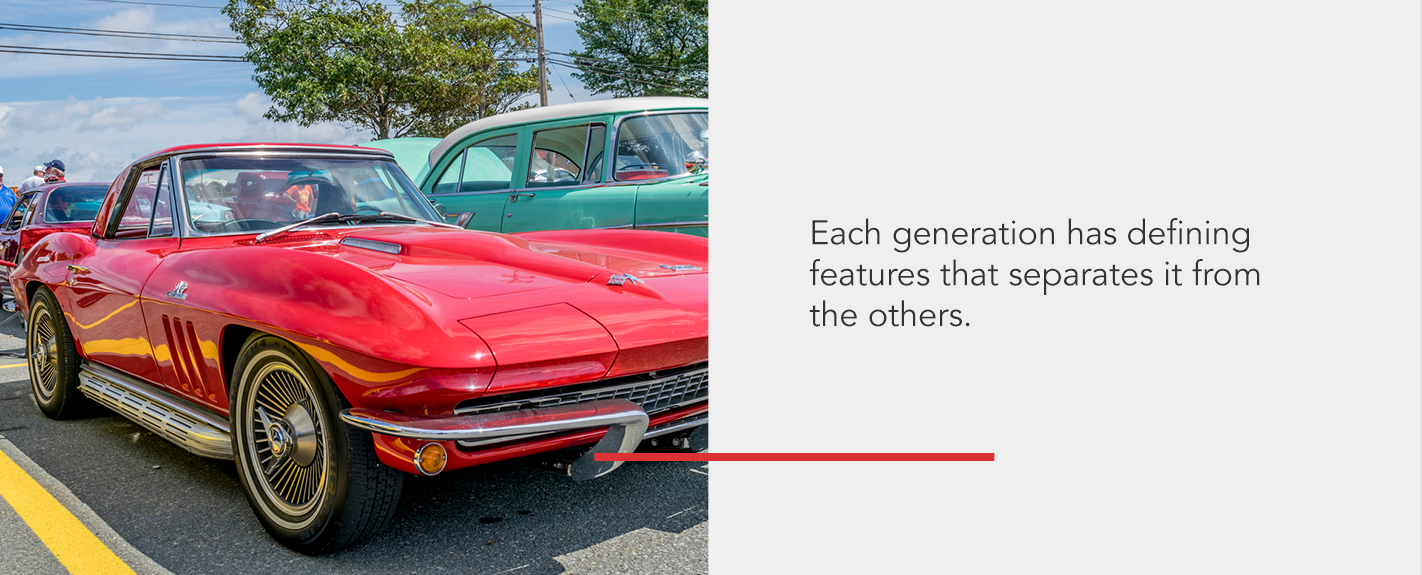
Second Generation 1963-1967 — C2
The difference between the C1 and C2 is that the newer generation underwent a complete restyle one decade after the Corvette’s release. The first two generations are few and far between. They were made in limited numbers and were all about the look and muscle of the car.
In 1963, Chevrolet engineered the first Corvette coupe. The Z06 engine was also offered on the Stingray, but only 199 were built, making them incredibly rare. The Big Block V8 engine was engineered in 1965 with 425 horsepower (HP). In 1966, Holley Carburetors became standard with all engines, and driver and passenger headrests were now an option.
The 1967 C2 was customizable with the L88 engine, but only 20 were produced. The same year, the car experienced some major additions, such as hazard lights and a dual master cylinder brake system. Chevrolet engineers removed and restyled the exterior trim, plus changed the fender vents and hood.
Buying a C2 Z06 Stingray or C2 with an L88 engine will be a rare and rewarding find.
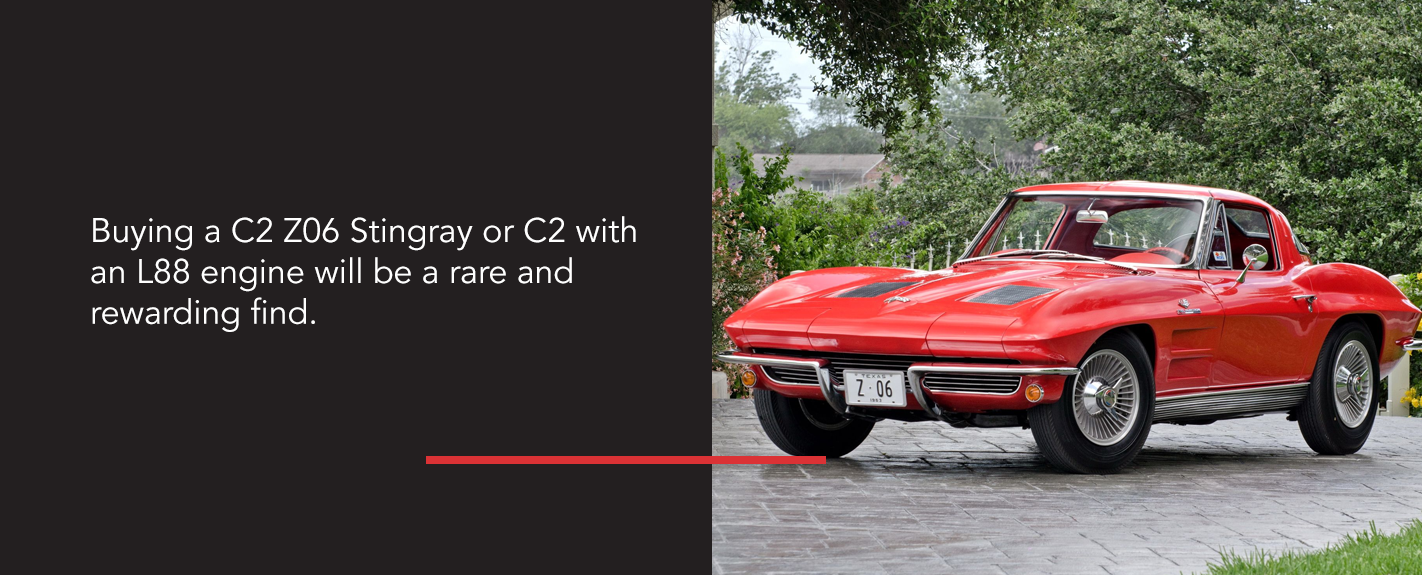
Third Generation 1968-1982 — C3
Another complete restyling occurred in the 1968 manufacturing process, making it the key difference between the C2 and C3. The third generation was the first car in the auto industry to have a “T-top” roof panel that you could remove. It also had “pop-up” headlamps.
The first time the ZR-1 racing package became available for Corvettes was in 1969. One year later, the new LT1 Small Block V8 engine arrived with 370 HP. 1972 was the last year Corvettes featured rear and front chrome bumpers, as well as side-fender grilles and an egg-crate grille.
The 500,000th Corvette was manufactured in 1977 with a white paint job and a red interior. The fastback body style made an appearance one year later, and in 1982, Chevrolet introduced the hatchback design that had a four-speed automatic transmission.
You can start to see a transition into more modern features with the C3 Corvette.
Fourth Generation 1984-1996 — C4
The fourth generation of Chevrolet sports cars saw continuous change throughout its 12 years. The C4 had a top speed of more than 150 mph and was also 24% more aerodynamic compared to the previous generations.
In 1985, the tuned-port injection of the 230 HP V8 was a significant improvement. The Chevrolet team also introduced the first convertible Corvette since 1975. Driver-side airbags become standard, and the ZR-1 model debuted in 1990.
In 1992, the Corvette’s 300 HP V8 engine was so impressive that it was given the LT1 designation. It was also the year that the one-millionth Corvette was manufactured. They copied the look of the first 1953 models by implementing a red interior and a white convertible.
In 1993, ruby red metallic exteriors and ruby red interiors were the signature look for Chevrolet’s 40th anniversary Corvette models.
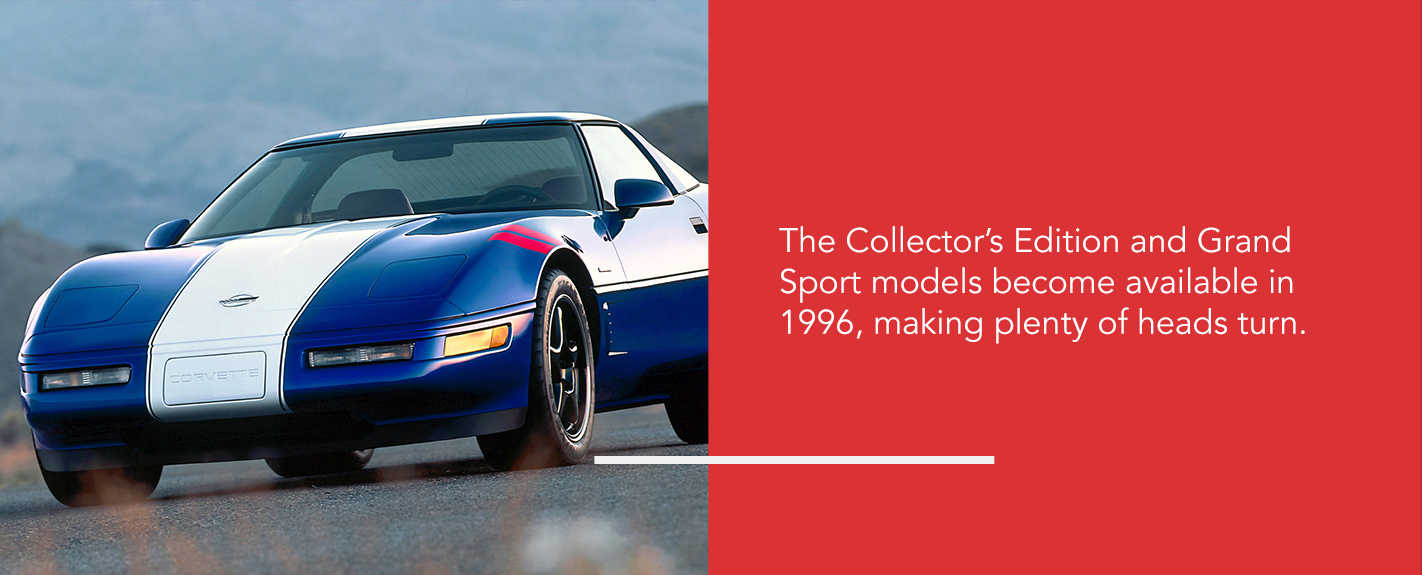
The Collector’s Edition and Grand Sport models become available in 1996, making plenty of heads turn. The Collector’s car had an LT1 engine with unique emblems and Sebring Silver paint. The LT4 Grand Sport had a blue exterior with a white stripe, along with red “hash marks” on the front left fender. Only 1,000 Grand Sports were made.
Fifth Generation 1997-2004 — C5
The C5 Corvette had a rear-mounted transmission and hydroformed side frame rails at the beginning of 1997 production. The 1998 model was the first time since 1962 that the convertible featured a separate trunk that you could access from the outside. 1998 was also the year the hardtop model with fixed roof panels arrived.
In 1999, the LS1 V8 engine delivered 348 HP, and by 2001, the Z06 was introduced with 385 HP and an LS6 V8 engine. The Z06 reached a top speed of more than 170 mph while delivering improved airflow because of a front fascia grilled. Engineers continued to advance the Z06, making it 405 HP in 2002.
The Corvette’s 50th anniversary Corvette rolled to the center of attention in 2003 with a red exterior, a two-tone shale interior, unique emblems and a Magnetic Selective Ride.
Anniversary Corvettes are often well sought after for restoration projects to get the car back to its original heyday image.
Sixth Generation 2005-2013 — C6
The sixth-generation Corvette underwent massive changes in an eight-year span. Chevrolet went with a complete redesign and engineering of the C6 by manufacturing a new Small Block V8 engine that had 400 HP. They also reintroduced exposed headlamps — which weren’t seen since 1962 — along with the power top feature for convertibles. 2005 also saw the introduction of more extravagant infotainment gear like OnStar and navigation.
In 2006, the Corvette was powered by a 505 HP V8 with a six-speed paddle-shift automatic. The LS3 V8 engine increased in horsepower to 430 in 2008, and the model offered leather interior options. In 2009, the super-charged ZR1 V8 6.2 L engine with 638 HP made a massive jolt in the industry. The Corvette could now reach a top speed of 205 mph.
Side airbags became standard on all the cars in 2010. That same year, the Grand Sport model returned. In 2011, the Z06 Carbon Limited Edition started in production where you had the choice between Supersonic Blue and Inferno Orange — two iconic looks.
The Chevrolet Corvette Centennial Edition debuted in 2012. It had a Carbon Flash metallic exterior, stain-black graphics and cup wheels. The wheels had a red stripe, while the interior of the Corvette showcased red stitching. The C6 is often seen as the best representation of the modern Corvette with its more profound body lines and emerging power.
Seventh Generation 2014-2019 — C7
In 2014, the Stingray designation returned to the C7 series. Aluminum frames became standard for all models, and Michelin was dubbed the exclusive supplier for Corvette tires. Throughout the next five years, Chevrolet focused on the sports car’s engine.
The Stingray had a V8 engine with 460 HP. The Z06 also returned with an LT4 aluminum 650 HP engine. The Corvette highlighted new performance levels, styles and technology with advancements in the industry. Engineers started to introduce new interior options as well as enhanced materials.
Eighth Generation 2020-present — C8
The 2020 C8 Stingray Corvette is by far the most advanced generation thus far. It is the first mid-engine Corvette produced and has been completely redesigned from the ground up. In fact, only a single part has been carried over from the previous generation. After many months of anticipation, Chevrolet has started production of this already iconic Corvette.
The C8 features 495 HP with an eight-speed dual-clutch transmission. While Chevrolet engineers cut the manual transmission from the specs, they didn’t skimp on the engine’s performance. The new Stingray can go 0-60 mph in an impressive 2.9 seconds. It’s also the first series to have a retractable hardtop that you can raise and lower while moving at speeds of up to 30 mph.
Other technology systems include the Front Lift system, Performance Data Recorder and Driver Mode Selector. The C8’s customization ranges from different packages for tires and seats to the Z51 performance platform. It even has right-hand steering available to reach other overseas markets, along with a race car-inspired steering wheel.
If you’re looking for performance and technology, the C8 will get your adrenaline pumping.
One Corvette generation may speak to you more than the others. No generation is better than any other. It simply has to do with what sports car features rev you up the most.
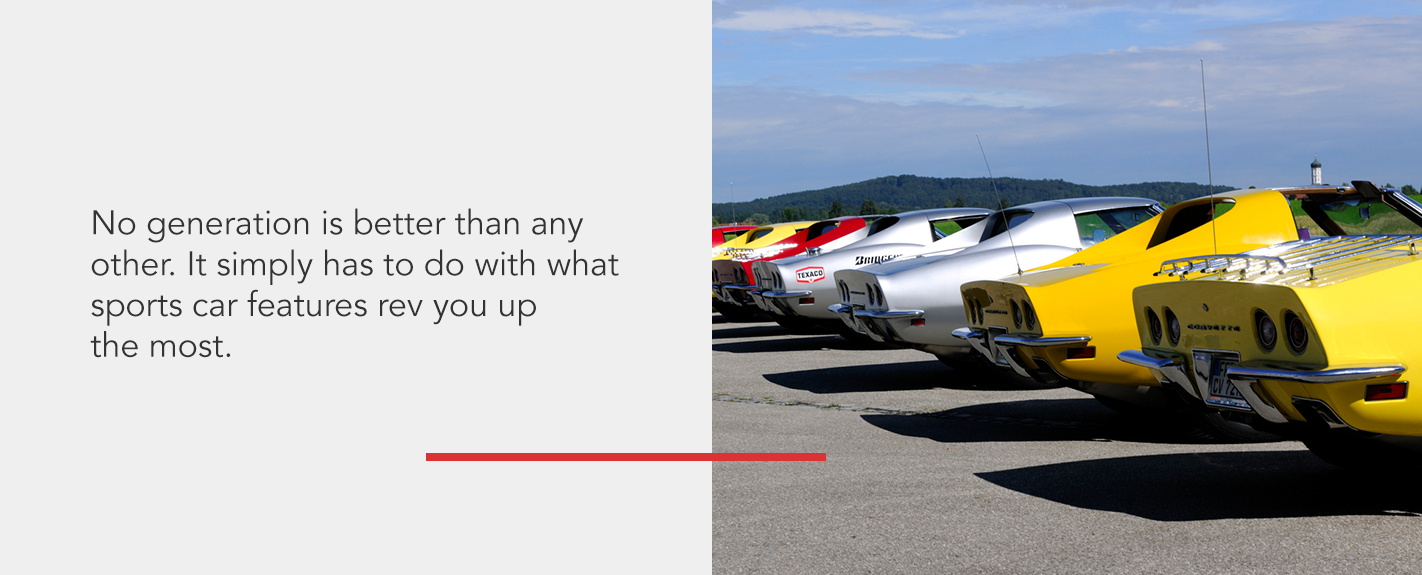
We Have Every Corvette Component You Need
Whether you’re in search of a classic Corvette or one that’s fresh off the lot, Top Flight Automotive has the largest product portfolio of Corvette parts. Our solutions meet or exceed original Corvette specifications to give you the right results the first time. Many of our quality restoration parts are OE licensed after rigorous approvals. As part of the Extra Mile Brands family of companies, we have more than 40 years of experience in Corvettes.
Work with our experienced sales reps to shop for parts, restoration products or exterior accessories. You can also contact us for additional support. Top Flight Automotive has built a tremendous reputation over the years by evolving with the market and technology to help Corvette enthusiasts like you.



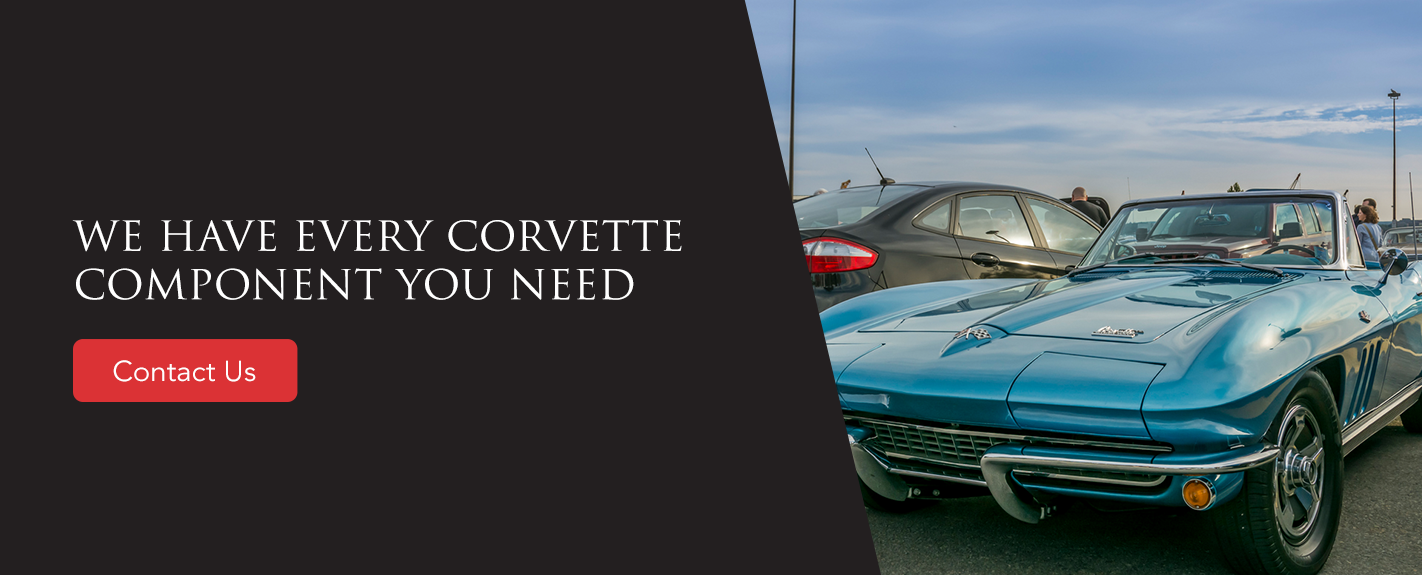







November 9th, 2020 at 4:40 pm (#)
Thanks